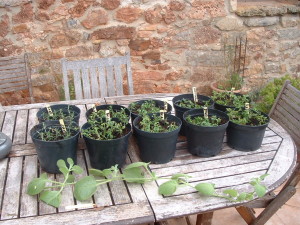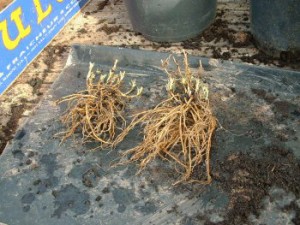Well March is upon us and it is time to take hundreds of tip cuttings, all the Thymes, Rosemary, Winter Savoury, Helichrysums, and Tercriums. It is also time to raise and separate the Mints and Tarragon, wild Geraniums and Dianthus. Sadly after the frosts the aromatic Pelargoniums got badly hit, I’ve clipped them back and have crossed my fingers and toes that they have not be totally frozen.
Tip Cuttings
 Armed with sharp clippers I clip the new green shoots off the plants, I cut them about two centimeters down and on a junction where there are side leaves, the reason is that these points have the highest concentration of growth hormones in the shoots so it increases the likelihood of a successful rooting. In organic horticulture the use of chemical hormone rooting powders is rightly forbidden but there are a few solutions available that will increase your cuttings success rate, the first is home made solutions, see Three Organic Alternatves to Hormone Rooting Powder, the second is to buy organically certified soil that already has organic hormone rooting solutions mixed in, we use both solutions depending on scale, when there is a lot to do we buy in Orgasyl soil mixed by the chemical giant Frayssinet. And there is a lot to do do now to ready us for the season ahead.
Armed with sharp clippers I clip the new green shoots off the plants, I cut them about two centimeters down and on a junction where there are side leaves, the reason is that these points have the highest concentration of growth hormones in the shoots so it increases the likelihood of a successful rooting. In organic horticulture the use of chemical hormone rooting powders is rightly forbidden but there are a few solutions available that will increase your cuttings success rate, the first is home made solutions, see Three Organic Alternatves to Hormone Rooting Powder, the second is to buy organically certified soil that already has organic hormone rooting solutions mixed in, we use both solutions depending on scale, when there is a lot to do we buy in Orgasyl soil mixed by the chemical giant Frayssinet. And there is a lot to do do now to ready us for the season ahead.
The tip cuttings usually take one to two months to take, I usually pop about 20 or so in a 10 cm deep pot, when I see signs of roots popping out the bottom it is time to up turn the pot and separate out and replant the new plants. They quickly adapt to their new home and start shooting up. I find that there is little difference if they are left outdoor or put in the poly tunnel, so they get left out to free up space in the tunnel for all the tomatoes and other heat loving seeds.
Most of our garrigue plants we reproduce through tip cuttings but it is also possible to reproduce mints this way, see Mint Tip Cuttings
Raise and Splitting
Some plants, like Mint and Tarragon, as well as wild Geraniums and Achillea millefolium, yellow marrow, are easily reproduced by lifting the entire plant in Spring and separating our the roots. Indeed in the case of french tarragon it the only way to get a true plant. It is possible to buy tarragon seeds but when sown they produce Russian tarragon, a tall rather tasteless annual that frankly is completely useless. To see how to reproduce Tarragon have a nose at the Organic French Tarragon guide I wrote a couple of years back.
Mints, in our garden the Iranian and the wonderfully aromatic Moroccan Mints are already pushing up new growth, the Peppermints, Spearmints, Bergamont Mint, Chocolate Mint and the always late Strawberry Mint are still sleeping. So I’ll start with the first two, the entire plant gets lifted, the roots beneath every shoot are split and replanted into their own pots, the largest ball of roots is then returned to the half barrels the mother plants live in; i also take the opportunity to refresh the sol in the barrels as I find mints hungry, and thirsty plants, the constant watering tends to drain the soil of its nutrients rather quickly so an annual refresh is always a good idea. This also allows me to lift the plant a second time in late Spring if sales have been going well.
I was working in a T shirt yesterday, but after last year’s end of Aprils frosts nothing can be taken for granted.



Some good tips (pardon the pun). I’m inspired to go and nurture our own herbs!
Sounds a plan, you can always do a tour of our plants next time you are in our corner of the world. Tarragon is a must for your local cuisine